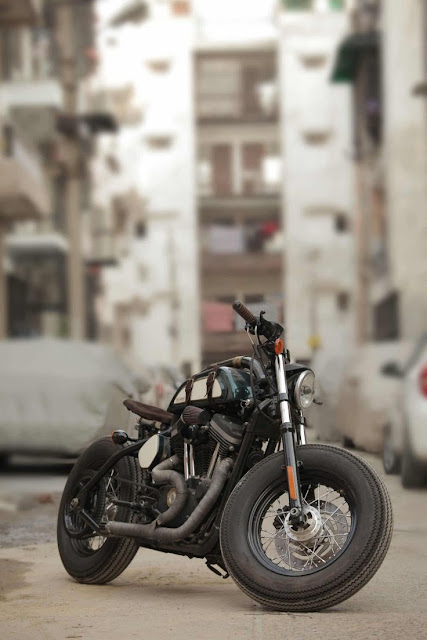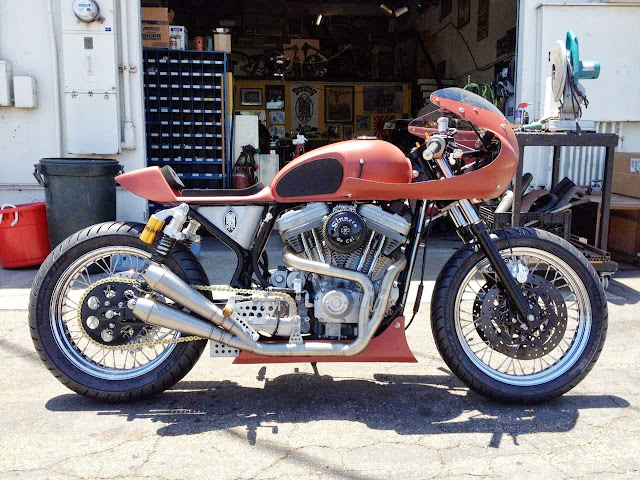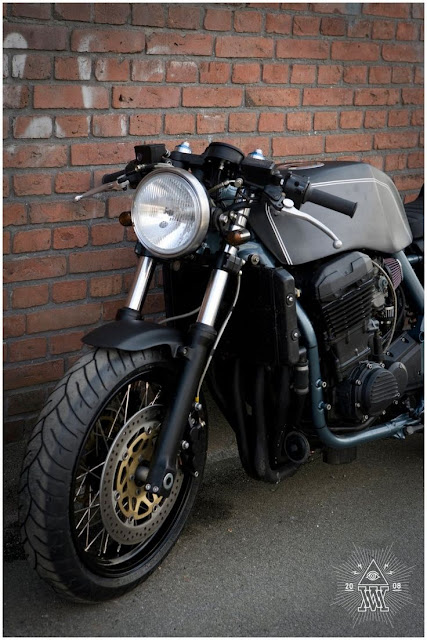Harley-Davidson Cafe Racer
The black-finished engine was essentially the same 998cc, 45-degree pushrod V-twin that powered the Sportster model, complete with identical 61 blip peak output.
With its handlebar fairing, V-twin engine and black paintwork, the XLCR was one of the most stylish bikes on the road, if not the fastest.
The most improbable contender in the suPei'b'ke battle of 1977 was a racy- wBH looking lOOOcc V-twin from Harley- Davidson. complete with headlamp fairing, all black paintwork and a serious dose of attitude. The XLCR Cafe Racer was a bold move from the Milwaukee firm, whose reputation for speed and performance had been surrendered long before, and whose range otherwise consisted only of cruisers and tourers.
Harley was keen to promote the Cafe Racer as a high-performance machine. The firm’s advertisements talked excitedly of 120mph (193km/h) top speed, and about how this was the most powerful production bike that Harley had ever built. In reality the XLCR shared many components with other models in the firm’s range, and was closer in performance and feel to Harley’s own laid-back Sportster than to rapid V-twins from the likes of Ducati and Moto Guzzi.
Willie G.’s project
The Cafe Racer was a visually striking machine for all that. The model was created by Harley design chief Willie G. Davidson, whose Super Glide of six years earlier had put struggling Harley back on track. As well as the small fairing, the XLCR had a large (by Sportster standards) fuel tank, a single seat that blended neatly into the rear fender, a tiny front fender, and a siamesed exhaust system with twin silencers. All were finished in black.
So was the engine itself, although apart from its cosmetic update the 998cc pushrod-operated 45- degree V-twin was identical to that of the standard XL Sportster. Gearing was one tooth lower for improved acceleration, but carburation was still by a single 38mm Keihin. As the new exhaust system made no difference to performance, peak output remained the Sportster’s 6lbhp at 6200rpm.
Chassis changes centred on a new frame, which combined twin front downtubes from the Sportster with a new rear section based on that of the XR750 racebike. This was more rigid and provided a more suitable, rearward mounting point for the shocks, which bolted to a box-section swingarm that was stronger than the XL’s tubular equivalent. Morris alloy wheels and a triple-disc brake system replaced the Sportster’s wire spokes, single front disc and rear drum.
The Cafe Racer’s riding position was sportier, too, thanks to near-flat handlebars and slightly rear- set footrests. This combined with the fairing’s wind protection to make the XLCR a handy bike for highway cruising. It sat at 70mph (l I3km/h) feeling stable and relaxed. Vibration became a problem above that speed, though, and the Harley lacked the power for truly competitive performance. Its top speed was not far off the claimed I20mph (I93km/h), but acceleration was modest and the four-speed gearbox rather crude.
Handling was acceptable, despite a tendency to weave at high speed, and a ponderous feel in slower comers. The Cafe Racer’s chassis was an improvement for Harley, who would later adopt its rear suspension arrangement on the Sportster too. But although the brakes were also praised, the XLCR’s overall performance and image did not impress many performance-oriented motorcyclists.
More importantly for Harley, the Cafe Racer also held little appeal for the American riders who formed the majority of the firm’s customers. This bike might have been Milwaukee’s fastest ever production machine, but Harley fans preferred the laid-back Low Rider, which was introduced in the same year and was a huge success. By contrast only about 3200 Cafe Racers were built in 1977 and ’78 before the model was dropped. The XLCR Cafe Racer was proof that, for Harley at least, faster did not necessarily mean better.
Handling was good by Harley standards, and the Cafe Racer was stable and fairly well controlled in slow speed bends, especially when its front forks were fitted with an aftermarket brace as with this example. But the combination of handlebar- mounted fairing and relatively thin steel frame tubes resulted in a tendency to weave at high speed.
Some bikes look good from every angle, and the XLCR is one of them. The Harley’s screen and flat handlebars combined to keep off the wind at speed. The twin disc front brake, backed up by another disc at the rear, gave much improved stopping power over the Sportster’s set-up of single front disc and rear drum.
Specification Harley-Davidson XLCR Cafe Racer (1977)
- Engine Air-cooled ohv pushrod four-valve 45-degree V-twin
- Capacity 998cc (81 x 96.8mm)
- Maximum power 61bhp @ 6200rpm
- Transmission Four-speed, chain final drive
- Frame Steel twin downtube
- Suspension Telescopic front; twin shocks rear
- Brakes Twin discs front; disc rear
- Weight 5151b (234kg)
- Top speed 115mph (185km/h)





















0 comments: